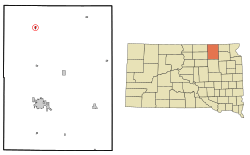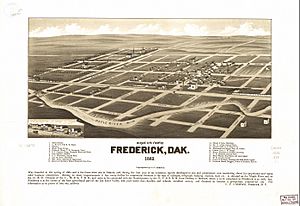Frederick, South Dakota facts for kids
Quick facts for kids
Frederick, South Dakota
|
|
|---|---|

Main Street in Frederick, August 2017
|
|

Location in Brown County and the state of South Dakota
|
|
| Country | United States |
| State | South Dakota |
| County | Brown |
| Incorporated | 1882 |
| Area | |
| • Total | 1.35 sq mi (3.51 km2) |
| • Land | 1.35 sq mi (3.51 km2) |
| • Water | 0.00 sq mi (0.00 km2) |
| Elevation | 1,378 ft (420 m) |
| Population
(2020)
|
|
| • Total | 215 |
| • Density | 158.79/sq mi (61.29/km2) |
| Time zone | UTC-6 (Central (CST)) |
| • Summer (DST) | UTC-5 (CDT) |
| ZIP code |
57441
|
| Area code(s) | 605 |
| FIPS code | 46-22860 |
| GNIS feature ID | 1267395 |
Frederick is a town in northwestern Brown County, South Dakota, United States. The population was 215 at the 2020 census. Home to the annual Frederick Finn Fest, the town is part of the Aberdeen Micropolitan Statistical Area.
History
Frederick was a railway town platted and sold to pioneers by the Chicago, Milwaukee & St. Paul Railroad, which completed track into it on September 12, 1881. Its grid of blocks was aligned by compass, with numbered avenues running north–south, and numbered streets running east–west. Main Street and Railway Avenue intersect at the grid's core. Incorporated on June 21, 1882, Frederick was named after the railroad's Finnish immigration agent and sales clerk—Kustaa "Frederick" Bergstadius.
On July 2, 1921, a tornado swept through the downtown and "practically every building in the town was demolished", but only one resident was killed, after his home was torn from its foundation while he was trying to get his family into the storm cellar.
Geography
According to the United States Census Bureau, the town has a total area of 0.39 square miles (1.01 km2), all land.
Frederick is on U.S. Route 281 and is drained by the Maple River.
Demographics
| Historical population | |||
|---|---|---|---|
| Census | Pop. | %± | |
| 1890 | 281 | — | |
| 1900 | 251 | −10.7% | |
| 1910 | 433 | 72.5% | |
| 1920 | 424 | −2.1% | |
| 1930 | 461 | 8.7% | |
| 1940 | 422 | −8.5% | |
| 1950 | 408 | −3.3% | |
| 1960 | 381 | −6.6% | |
| 1970 | 359 | −5.8% | |
| 1980 | 307 | −14.5% | |
| 1990 | 241 | −21.5% | |
| 2000 | 255 | 5.8% | |
| 2010 | 199 | −22.0% | |
| 2020 | 215 | 8.0% | |
| U.S. Decennial Census 2017 Estimate |
|||
2010 census
As of the census of 2010, there were 199 people, 101 households, and 56 families living in the town. The population density was 510.3 inhabitants per square mile (197.0/km2). There were 119 housing units at an average density of 305.1 per square mile (117.8/km2). The racial makeup of the town was 98.5% White, 0.5% Asian, and 1.0% from two or more races.
There were 101 households, of which 22.8% had children under the age of 18 living with them, 47.5% were married couples living together, 2.0% had a female householder with no husband present, 5.9% had a male householder with no wife present, and 44.6% were non-families. 41.6% of all households were made up of individuals, and 18.8% had someone living alone who was 65 years of age or older. The average household size was 1.97 and the average family size was 2.66.
The median age in the town was 51.4 years. 19.6% of residents were under the age of 18; 2.4% were between the ages of 18 and 24; 21.5% were from 25 to 44; 29.1% were from 45 to 64; and 27.1% were 65 years of age or older. The gender makeup of the town was 55.3% male and 44.7% female.
Notable person
- Edward John Thye, former governor of Minnesota (1943-1947)
See also
 In Spanish: Frederick (Dakota del Sur) para niños
In Spanish: Frederick (Dakota del Sur) para niños



